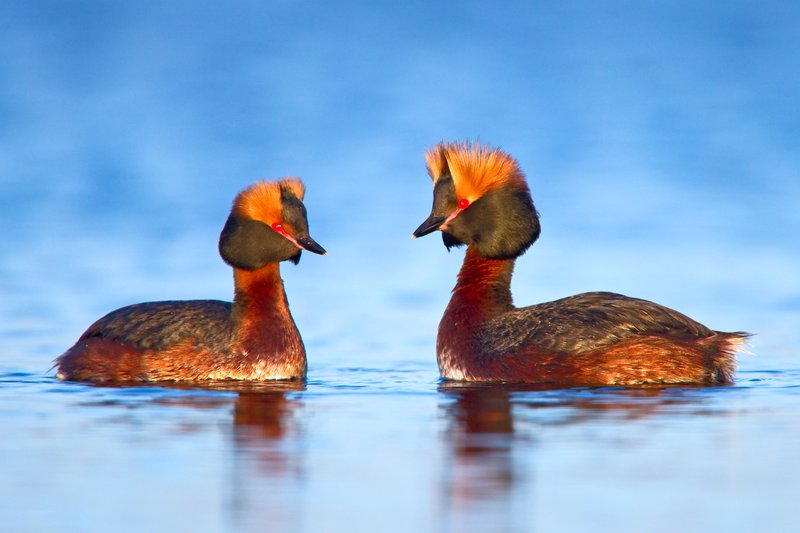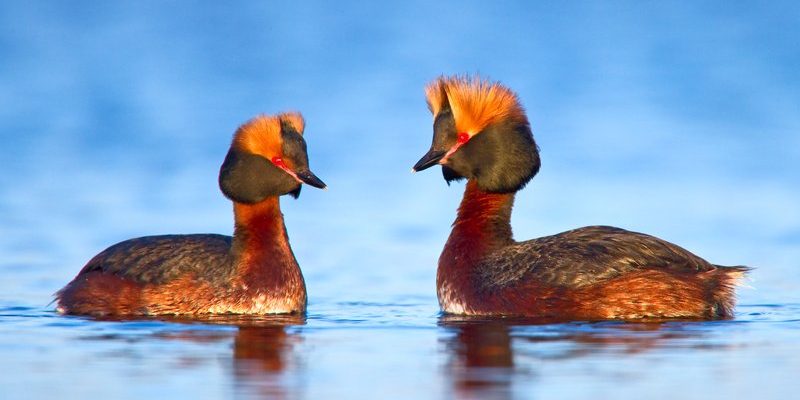
Grebes are fascinating aquatic birds known for their unique adaptations to life on the water. They belong to the family Podicipedidae, which includes about 22 species found worldwide. If you’ve ever seen a bird gliding gracefully across a lake, chances are it was a grebe. With their slender bodies, elongated necks, and distinctive diving abilities, grebes capture the imagination of birdwatchers and nature lovers alike.
These birds are not just pretty to look at; they play a vital role in their ecosystems. Grebes are expert divers, using their buoyant bodies and powerful legs to propel themselves underwater. They primarily feed on fish, invertebrates, and other aquatic organisms, making them essential for maintaining the balance in their habitats. Their unique courtship displays and vocalizations add to their charm, making it a delight to spot one in the wild.
In this article, we’ll explore the various aspects of grebes, including their physical characteristics, behavior, diet, and conservation status. So, whether you’re a seasoned birder or just curious about wildlife, let’s dive in!
Physical Characteristics of Grebes
Grebes exhibit various physical traits that help them thrive in aquatic environments. Their bodies are streamlined, which allows them to move efficiently through water. They have long, slender necks that can easily twist and turn, enabling them to spot prey. One of the most striking features of grebes is their brightly colored plumage, especially during the breeding season. Males and females often have different coloration, with males showcasing vibrant patterns to attract mates.
Most grebe species are relatively small, ranging from about 12 to 24 inches in length. Their size can vary, but they usually weigh between 1 and 3 pounds. They have particularly large feet that are positioned far back on their bodies, enhancing their swimming capabilities. This unique foot placement can make walking on land a bit clumsy, but it’s perfect for powerful dives and rapid swimming.
When submerged, grebes are nearly invisible due to their specialized feathers. These feathers are water-resistant, allowing them to stay dry while swimming. Additionally, their legs are equipped with sharp claws that assist in grasping slippery fish. All these adaptations make grebes some of the most skilled aquatic birds around.
Habitat and Distribution
Grebes are found on nearly every continent, inhabiting both freshwater and coastal marine environments. They prefer habitats with calm waters such as lakes, ponds, marshes, and slow-moving rivers. You might spot them in wetlands or along shores where they can dive for their favorite snacks. Interestingly, different species of grebes have adapted to specific habitats; for instance, some are more common in northern regions, while others thrive in tropical climates.
During the breeding season, grebes typically build their nests in dense vegetation near water. They create floating nests made from reeds and other aquatic plants, which are anchored to the surrounding foliage to keep them stable. This makes it easier for them to care for their eggs and chicks once they hatch. Depending on the species, grebes can be migratory or resident, moving between different bodies of water depending on the season.
As climate changes and human activity continue to impact natural habitats, grebes face various challenges. Wetland destruction and pollution threaten their homes, making conservation efforts crucial for their survival. Awareness and preservation of their habitats can significantly impact these beautiful birds.
Diet and Feeding Habits
Grebes are carnivorous birds that primarily feed on fish, crustaceans, and aquatic insects. Their diet is closely tied to their habitat, and they’ll often dive deep to catch a meal. Using their keen eyesight, they can spot prey from the surface of the water before plunging down to grab it. Grebes are so efficient at foraging that they can dive for up to 30 seconds to 1 minute, depending on the species.
In addition to hunting, grebes have interesting feeding behaviors. They are known to swallow their prey whole and can even consume the bones of small fish. They also train their chicks to dive for food early on, teaching them essential survival skills. This parental care is vital, as young grebes are often vulnerable to predators and need to learn how to fend for themselves quickly.
Interestingly, grebes will sometimes consume their feathers — a behavior called “feather ingestion.” This may help them digest sharp fish bones and aid in the overall health of their digestive systems. Such unique feeding habits make grebes truly remarkable creatures in the bird world.
| Characteristic | Details |
| Size | 12-24 inches in length |
| Weight | 1-3 pounds |
| Habitat | Freshwater lakes, ponds, marshes |
| Diet | Fish, invertebrates, aquatic insects |
| Diving Ability | Dives for 30 seconds to 1 minute |
| Breeding Season | Spring and summer |
| Conservation Status | Varies by species; some are threatened |
Reproduction and Nesting Behavior
The courtship rituals of grebes are nothing short of spectacular. During breeding season, males perform elaborate dances on the water’s surface, showcasing their plumage to attract females. You might see them twisting their necks, bobbing, and even diving in synchronized displays. This is not just for show; it’s a crucial part of their mating process and helps strengthen pair bonds.
Once a pair mates, they work together to build a floating nest. They typically choose secluded areas with abundant vegetation, as this provides safety from predators. The nest itself is a fascinating construction, made from reeds and other plant materials, floating on the water. Female grebes lay around 2 to 6 eggs, which are usually pale in color with speckles. Both parents share the responsibility of incubating the eggs, which takes about 20 to 30 days.
When the eggs hatch, the adorable chicks are precocial, meaning they can swim and dive almost immediately. Parents will often carry their young on their backs to protect them from potential threats. This parental care continues as they teach their chicks how to forage and evade predators. Watching a family of grebes navigate the water together is a heartwarming experience for any nature enthusiast.
Conservation Status
As with many wildlife species, grebes face various threats that can impact their populations. Habitat loss due to urban development, pollution, and climate change are the primary concerns. Wetlands are disappearing at an alarming rate, diminishing places where grebes nest and feed. Some species, like the Californian Clapper Rail and the Western Grebe, are of particular concern due to their declining numbers.
Conservation efforts play a critical role in protecting grebes and their habitats. Organizations and wildlife agencies are working to restore wetlands and create protected areas for these birds. Additionally, public awareness campaigns aim to educate people about the importance of wetland ecosystems and the role grebes play in them. By supporting local conservation efforts and practicing responsible wildlife viewing, you can contribute to the preservation of these stunning birds.
Engaging in sustainable practices, such as reducing pollution and supporting conservation organizations, can make a significant difference in the survival of grebes and other wildlife. Every little action can help safeguard their future.
FAQ
What are the most common species of grebes?
Some of the most common grebe species include the Great Crested Grebe, the Pied-billed Grebe, and the Eared Grebe. Each has unique features and adaptations, but all share the same fundamental traits that make them excellent swimmers.
Do grebes migrate?
Yes, many grebe species are migratory. They typically move between breeding and non-breeding grounds based on seasonal changes. Migration patterns can vary significantly depending on the species and the location of their habitats.
How long do grebes live?
The lifespan of grebes varies by species, with many living around 5 to 15 years in the wild. Some individuals may live even longer under favorable conditions. However, factors like predation and environmental changes can affect their longevity.
Are grebes social birds?
Grebes can be social, especially during the breeding season when they form pairs. In the winter, they may gather in small groups or flocks, particularly in areas with abundant food. However, they are not as gregarious as some other waterfowl.
How do grebes communicate?
Grebes communicate through a mix of vocalizations and displays. Their calls can be quite distinctive, ranging from soft whistles to loud clucking sounds. These calls play a key role in attracting mates and establishing territory.
What is the difference between grebes and ducks?
Grebes and ducks are both waterfowl but belong to different families. Grebes have unique adaptations for diving, with their feet situated further back on their bodies, while ducks are generally built for both swimming and walking.
Can grebes walk on land?
Grebes are not well adapted for walking on land due to their body structure. They have difficulty moving on solid ground, as their feet are positioned for swimming. When they need to move on land, they often shuffle awkwardly.
Are grebes endangered?
Some grebe species are at risk due to habitat loss, pollution, and hunting pressure. While not all species are endangered, protecting their habitats is crucial to ensure their survival.
What do grebes eat in the wild?
Grebes primarily feed on small fish, crustaceans, and invertebrates found in their aquatic environments. Their diet is heavily influenced by the availability of food in their habitats.
How can I help protect grebes?
You can help protect grebes by supporting local conservation initiatives, practicing responsible wildlife viewing, and reducing pollution in waterways. Every action counts in preserving the natural beauty of our environment and the creatures that inhabit it.
Do grebes have any natural predators?
Yes, grebes face threats from various natural predators, including birds of prey, large fish, and some mammals. Their best defense is often to remain hidden in vegetation or to dive underwater to escape danger.
How do grebes care for their young?
Grebes provide dedicated parental care to their chicks, often carrying them on their backs to protect them. They teach their young how to forage for food and avoid predators, ensuring they survive in their early days.
What are the notable behaviors of grebes during courtship?
During courtship, grebes perform elaborate displays that may include synchronized swimming, head bobbing, and vocalizations. These displays help strengthen pair bonds and attract mates, showcasing their beauty and skills.

